

EVM-EL-03-03-01
STX4 EVOM™ Electrode with Removable Blades for TEER in 6.5 mm Inserts
- Overview
- Specifications
- Accessories
- Citations
- Related Products
Overview
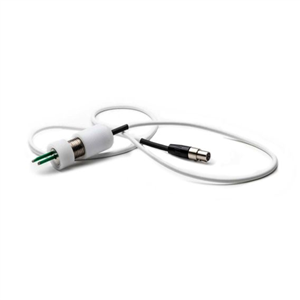
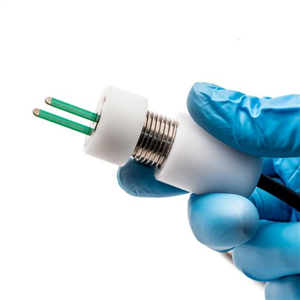
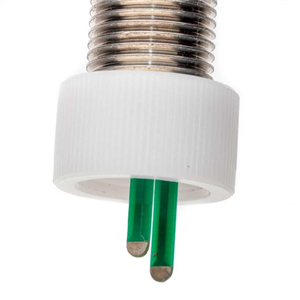
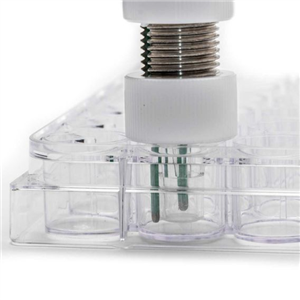
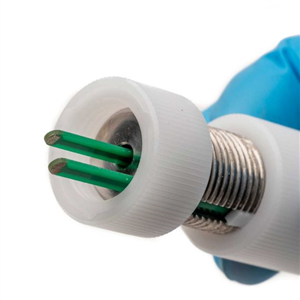
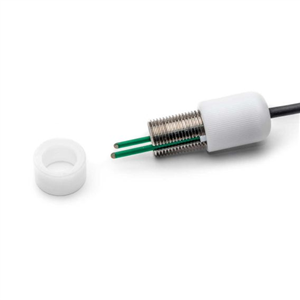
There are 6 images available to view - click to enlarge and scroll through the product gallery.
STX4 Manual
/ Download as PDF
STX4 Plates Compatibility Table
/ Download as PDF
Electrode for EVOM3 and EVOM™ Manual with Replaceable Blades Ensures Stable Measurements
The STX4 electrode is the most recent version of chopstick electrode for the EVOM3 and EVOM™ Manual and it is designed to facilitate measurements of voltage (potential difference: PD) and resistance (transepithelial electrical resistance: TEER) of cultured epithelia (cellular layer) grown onto permeable membrane inserts in 12- and 24-well tissue culture plates. STX4 can measure directly inside the well plates with 12 and 24 inserts. The STX4 is designed primarily for 24-well hanging inserts or transwells (e.g., Corning 3470), and the electrode’s best performance can be seen in this format.
To use with legacy meters including the EVOM2 order adapter cable EVM-AC-02-01-01.
Benefits
-
Replaceable blades – This new STX4 electrode has replaceable electrode blades.
-
No chloriding necessary – Electrode tips are specially coated, requiring no chloriding (maintenance step) to ensure proper electrode functionality when measuring TEER of cellular layers like epithelial cultures. Chloriding was necessary for the STX2-PLUS.
-
Less liquid volume needed – This electrode requires with less liquid volumes than required for STX2-PLUS electrode to keep the tips immersed and able to provide stable readouts.
-
Hands-free operation – The STX4 electrode fits perfectly in 24-well hanging transwells cell culture well plates and can stay hung on top of these transwells, allowing for hands-free operation.
-
Greater precision – The STX4 electrode offers better TEER measurement precision, because it eliminates the variability factors resulting from change in electrode spacing and positioning as seen with STX2 electrode.
-
Shielded from radio frequency interference (RFI) – This STX4 electrode has a shielded cable and eliminates or minimizes any interference (from electrical sources or cell phones) affecting the TEER measurement read outs.
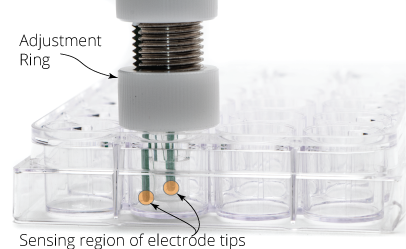
The STX4 electrode sits on the well for hands-free operation, and the adjustment ring lets you place the electrode blades in the well exactly where they need to be, suspended in solution without touching the membrane or the bottom of the cell culture well plate.
NOTE: Improve your TEER measurement precision with the older EVOM2 by swapping out the STX2 or STX3 with the new STX4. STX4 can be used with the EVOM2 (previous model) by using the 99675 adapter, which is sold separately.
Features
-
Electrode blades are replaceable. Over a period of use (after months or years) when the electrodes may have formed deposits from media or samples and may start showing reading instability, you may change the blades without having to replace the entire electrode.
NOTE: Regular or daily cleaning after use will extend the functional life of the electrode blades. -
The electrode tip is specially coated and does not need to be chlorided with bleach or sodium hypochlorite for proper functioning, and it is not affected by chloriding either. Chloriding was critical for the previous model (STX2-PLUS electrodes) to maintain its functionality.
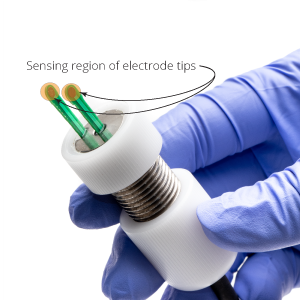
STX4 Electrode Tips, the sensing region, have a special coating that doesn't require chloriding.
-
The electrode tip (active sensing area) of STX4 is shorter than the STX2-PLUS. Being specially coated, it does not need to have large area as STX2-PLUS. Therefore, the STX4 electrode requires less apical (top of the insert) and basolateral liquid (media) volumes than STX2-PLUS to keep the electrode tips fully immersed and able to provide stable TEER measurement read outs.
-
The STX4 electrode fits ideally on 24-well hanging transwells cell culture inserts (e.g., Corning 3470) and can stay hung on top of these. This allows hands-free operation which further improve measurement precision.
-
The STX4 electrode has improved measurement precision since the electrode design, which is similar to the STX2-PLUS, eliminates or minimizes variabilities introduced by the electrode positioning seen with the STX2 or STX3. The STX2 or STX3 electrode is handheld, and its flexible design is susceptible to the electrode tilting, which changes the gap between the two electrode blades during measurement. Capturing a steady and consistent value within the same sample group using an STX2 or STX3 is challenging. STX2 or STX3 users generally take multiple measurements of the same sample and use an average when using these electrodes. With the STX4 electrode, multiple measurements of the same sample is not required.
-
The STX4 electrode has a shielded cable, and even the metal body of the electrode is tied to the shielding mechanism. By minimizing or eliminating electrical and cell phone interference, the shielding ensures that the TEER measurement and read outs are stable (do not fluctuate) and are unaffected by interference.
Key STX4 Improvements Over STX2-PLUS
-
Save resources, because the STX4 needs less liquid volumes.
-
Save time, because the STX4 nees less maintenance. No chloriding is required.
-
The STX4 is more cost-effective in the long run, because the electrode blades are user replaceable.
Refer to the table below for details (Differences and Similarities between STX4 and STX2-PLUS)
| Type | STX2-Plus | STX4 |
| Liquid Volumes Required for Stable Measurements | Greater liquid (media) volumes per sample are required to keep the longer sensing regions fully immersed in order to get stable readings with STX2-PLUS. Example volumes: For Corning 3470, 24-well transwell, minimum 300 µL on the top (apical) and 850 µL on the bottom (basolateral) media volumes are needed for STX2-PLUS. |
Less liquid (media) volumes per sample are required for the STX4 to get stable and accurate readings. Because the sensing regions of the STX4 are shorter and specially coated, the STX4 needs less liquid volumes than the STX2-PLUS. The use of less media with the STX4 saves your resources. Example volumes: For Corning 3470, 24-well transwell, minimum 150 µl apical media and 500 µl basolateral media volumes are needed for STX4. |
| Chloriding (User Maintenance) Required | Yes, it is important. When used daily, the electrode needs to be chlorided by immersing the electrode tips in 3-6% sodium hypochlorite for 10 minutes (followed by a rinse with DI water) to ensure proper electrode functionality. |
No, it is not required. The electrode does not need to be chlorided. (It is also functionally unaffected by chloriding.) A special coating of the electrode’s sensing regions ensures proper functionality. Less maintenance is required by a user, which saves you time. |
| User Replaceable Blades (These blades come in direct contact with samples and contain the sensing region.) | No. Blades are nondetachable. |
Yes. You have the option of changing the blades, making the STX4 more cost-effective in the long run. |
| Application | • Ideal for 24-well transwell cell culture plates. • Used in resistance and millivolts measurements. |
Same as STX2-PLUS |
| Direct connectivity with EVOM3 | Yes | Yes |
| Compatibility with EVOM2, EVOM, Millicell ERS-2, and ERS (using 99675 adapter) | Yes | Yes |
FAQs
Do the STX4 electrode blade tips tend to darken over the period of use or during storage?
Yes, it is a normal process. The STX4 electrode tips tend to darken (cosmetic), but the electrode or the electrode blade functionally remains unaffected.
Can the STX4 electrode blade tip color be significantly different on the outer side as compared to the inner side?
Yes, it is normal (cosmetic) and can be attributed to the path of current flow between the two electrode blades. Generally, the outer side of electrode blade tips will tend to darken more since the outer electrodes are involved in applying electrical current from the EVOM (Fig. 29). The inner side of the electrode blade tips will tend to remain relatively whitish (tip color), since no electrical current passes through that side. These inner electrodes (the inner side of the electrode blade tips) are involved in the detection of change (voltage) in response to applied current. This observed difference or inconsistency of the tip color (inner side versus outer side) does not affect the actual function of the electrode blade or the electrode.
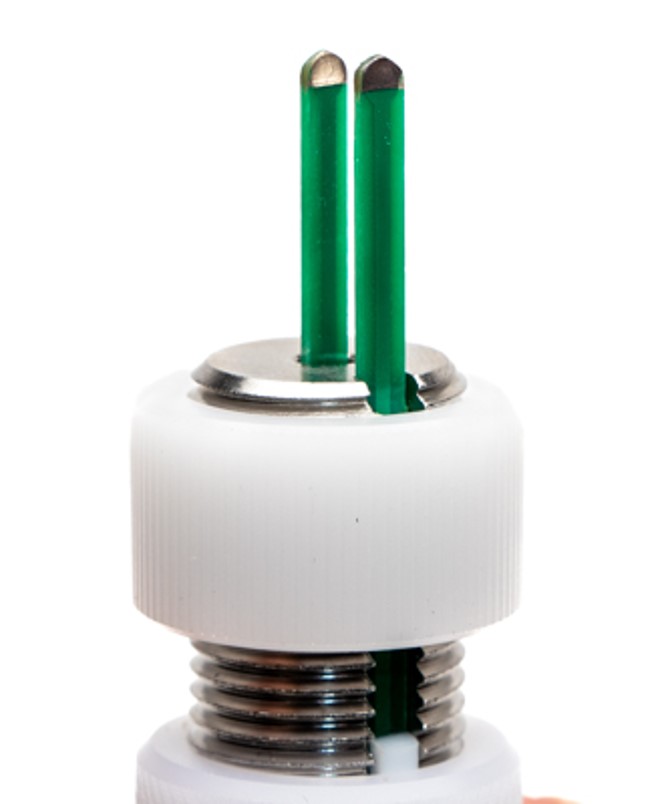
The darkening of the STX4 electrode tip and a significant difference in color between inner and outer sides of the electrode blades (during storage or after a period of use) are considered normal.
NOTE: WPI performs special conditioning of all electrode blades individually (especially the tips) and verifies proper functionality of each manufactured electrode blade and STX4 electrode.
Why am I getting dashes or unstable readings on EVOM3, even if I have the STX4 electrode inside the sample?
An electrode in air or partially immersed in the liquid can show dashes since it records unstable read outs. The electrode tip portion (sensing region) must stay fully immersed. You may also notice unstable read outs when the electrode tip is not fully immersed. Make sure to select apical and basolateral volumes so that the electrode tips of both electrode blades stay fully immersed.
Rotate the length adjustment ring clockwise so that the electrode blades can enter deeper into a sample and the electrode tips may be able to stay fully immersed in the liquid volumes.

Exposed length can be adjusted on the STX4 electrode blades by rotating the adjustment ring.
Make sure that the electrode sensing tips on both blades stay fully immersed in a conductive liquid (cell culture media or buffer) during measurment. You need to have adequate apical and basolateral volumes to get a stable reading.
Does the electrode need to be cleaned daily?
Yes, it is critical that after daily use. Clean the electrode and let it air dry, and store the electrode in a dry condition. It is required for functional longevity of the electrode blades. Refer to the MAINTENANCE section from the STX4 instruction manual for details.
Are there any other electrode handing instructions that WPI recommends?
- Always lift the electrode by the body, never by the cable. It can physically break the internal connections gradually.
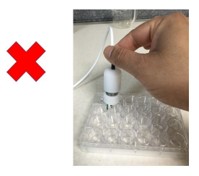
A. Do NOT hold the electrode by the cable. (Incorrect Handling)
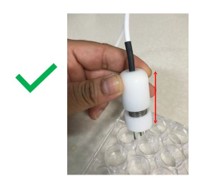
B. Hold the electrode by the plastic region indicated by the red arrow. (Correct Handling)
-
Limit the liquid immersion or liquid spray level somewhere below the maximum level indicated by the arrows in the image below. You don’t want the liquid to get inside and reach up to the cables or connectors. You can wipe the rest of the electrode with a paper towel sprayed with isopropanol or ethanol. (Do not spray directly.)
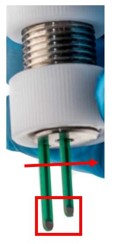
Liquid immersion should be limited only up to this line from the tip (maximum). The rest of the electrode can be wiped with a damp paper towel.
Are my inserts or transwells compatible with STX4 electrode?
The STX4 electrode works ideally with commonly used 24-well hanging inserts (such as, Corning, Millipore, and Greiner). The electrode can be used with most other 24-well inserts and 12-well inserts. For 12-well inserts, the electrode needs to be handheld or supported by hand while measuring. The list of compatible inserts can be found here or listed in “APPENDIX B: COMPATIBLE INSERTS AND PLATES” of the STX4 instruction manual.
Can increasing or changing sample liquid volumes change my resistance values?
Yes. You can expect to see a change of raw resistance values. However, you should subtract the blank values (blank transwell with no cells) from the sample values (transwell with cells). This way, you subtract the blank value with increased volume from samples with increased volume. Thus, any change of resistance contributed by increased volume is omitted. Consistently use the same volumes for all your samples in an experimental setup.
Are the electrical resistance and transepithelial electrical resistance (TEER) the same thing?
No. Multiply the measured resistance by the appropriate surface area of the membrane to calculate TEER. For example, if a 6.5 mm (24-well plate) insert measures 565 Ω, the TEER is:
565 Ω × 0.33 cm2 = 186.45 Ω-cm2
[For a 24-well plate (6.5 mm insert), area = 0.33 cm2 and for a 12-well plate (12 mm insert) area = 1.13 cm2. Please refer to the manufacturer’s technical details of the specific insert/transwell (for example, Millipore, Corning, etc.) to find accurate information about the membrane area applicable to a specific insert part number.]
Can you suggest some experimental parameters that can be controlled to obtain more consistent TEER results?
-
Temperature is known to affect TEER values. We recommend that you maintain a consistent sample temperature to obtain consistent values. We suggest taking the well plate with inserts containing cells out of the incubator and letting the plate stabilize at room temperature inside the laminar flow hood for 15-20 minutes before taking measurements. By this time, all the samples will be around the same room temperature.
-
After adding liquids to transwells, wait for 15 minutes before taking measurements. The liquid levels inside and outside of the insert will tend to come to the same height or level and will provide better reading stability.
-
We recommend using the same conductive liquid with the same ionic concentration both in the apical (top of the cell culture insert) and the basolateral (bottom of the insert) sides. For example, use the same media both inside and outside of the insert.
-
Application of consistent volumes of the fluid (media/buffer) during all experiments reduces variability.
Specifications
Accessories
EVM-AC-02-01-01
Mini XLR to RJ-11 Adapter Cable For Legacy TEER Meters
- Enables TEER elect...

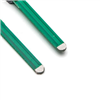
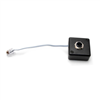




Request
Catalogue
Chat
Print